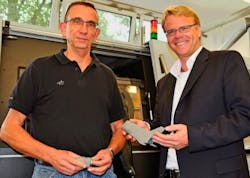Generative metal laser fusing used to create model of reusable space vehicle
Lichtenfels, Germany--A scale model of the proposed European space vehicle Alpha suitable for wind-tunnel testing has been fabricated via Concept Laser's LaserCusing process. The generative-fabrication technique uses a laser to melt titanium powder in a closed, oxygen-free environment.
Alpha is an air-launched reusable suborbital space vehicle under study by the European Space Agency (ESA). The final, full-scale Alpha would be launched from a carrier plane and rocket-propelled into a suborbital trajectory. After reaching the maximum flying altitude of roughly 100 km, it would glide back down to its point of departure and land automatically. The Deutsches Zentrum für Luft- und Raumfahrt (DLR; the German Center for Air- and Spaceflight) is constructing the scale model using LaserCusing equipment.
Before the fabrication process, the LaserCusing enclosure is flooded with argon gas, which remains the only surrounding gas until the powdered-metal and laser fabrication run is completed. The result is a thin-walled, yet strong Alpha model with a porosity of only 0.02% and a surface roughness of Ra 7-8. By using a downstream blasting process, it is possible to achieve the required surface roughness of Ra 1.6. At this point, the model is ready for a flight in the wind tunnel.
The scaled titanium model was produced by Jürgen Mengering, LaserCusing expert, and Markus Boje, head of the DLR's Systemhaus Technik.
Prospects for generative technology
In addition to larger part sizes, the need is increasing for hybrid parts, which can, for example, be made partly of copper and partly of steel (the copper aids in heat dissipation). To improve surface quality, various methods are currently being tried at the DLR, including coating, electrolytic polishing, automated grinding processes, and blasting processes. DLR's working relationship with its system partner Concept Laser is excellent in terms of the process support, and the potential of the technology is only in its infancy, as Markus Boje sees it. The DLR currently has two LaserCusing machines in operation, one in Cologne-Porz-Wahnheide and the other in Göttingen.

John Wallace | Senior Technical Editor (1998-2022)
John Wallace was with Laser Focus World for nearly 25 years, retiring in late June 2022. He obtained a bachelor's degree in mechanical engineering and physics at Rutgers University and a master's in optical engineering at the University of Rochester. Before becoming an editor, John worked as an engineer at RCA, Exxon, Eastman Kodak, and GCA Corporation.
